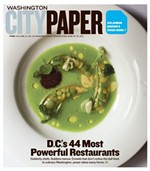Grass Roots
When Sean Farrell is asked, “Do you turn on?” he replies, “No. I smoke grass.” He then goes on to say that he eats grass, too—which he actually prefers—that other drugs are scary, and that you can tell a speed freak by how skinny he is. He knows that people get busted for weed but doesn’t believe it will happen to him. It’s not because Farrell believes he’s smarter than everyone else, as those who break the law often do. Rather, it’s because he’s “too little.” See, when this interview took place, in 1969, Farrell was 4.
Following Sean is writer-director Ralph Arlyck’s second movie about Farrell, the sharp, chatty son of his one-time upstairs neighbors. Arlyck, a native New Yorker, was living in San Francisco’s Haight-Ashbury when he decided to turn Farrell into a film-school project. He used a skateboard to track the restless kid as he ran around the neighborhood, and he eventually sat Farrell down for a quick talk about topics ranging from why he doesn’t wear shoes (“They’re sweaty”) to rudimentary anatomy (“You need bones so you don’t...squash”). Farrell also says that his family has a dog because the cops bother them, then thinks a second and asks, “Why are the police around so much? Huh?”
Arlyck’s resulting short, Sean, became a minor sensation, winning festival awards and even a White House screening. What stirred up audiences most, of course, was Sean’s drug use, and for this Arlyck felt some guilt: “This boy and his family have become a symbol,” he says early in Following Sean. “And it was my fault.” Farrell wasn’t the only symbolic subject Arlyck trained his camera on while living in the counterculture’s most famous neighborhood, though: He captured hippies hanging out, hippies doing drugs, and, of course, hippies evading the fuzz. Some of this footage has been integrated into Arlyck’s full-length follow-up to Sean, most of which he filmed between 1994 and 2003, after tracking down the former kiddie stoner and his parents.
Following Sean became much more than a whatever-happened-to-that-kid story, however. Arlyck, who made a few other documentary shorts after his student project and has taught film production at Vassar, found parallels in Farrell’s history and his own: Farrell’s West Coast grandparents were active Communists; Arlyck’s East Coast parents dabbled in but never committed to the Reds. Both of the men married expatriates, too: Arlyck began a relationship with a Frenchwoman while he still lived in the Haight, and Sean meets a Russian woman during Following Sean’s filming. These similarities helped Arlyck turn his doc into a delicately woven, generation-spanning examination of family, idealism, and the classic question of nature versus nurture.
Arlyck’s light touch makes Following Sean a mesmerizing 87 minutes. Combining still photos with film, the movie touches on everything you expect of the late ’60s: the civil-rights demonstrations, the police riots, the whole job-as-shackles lifestyle. These sequences are shown in whatever format the director had handy, in color and in black-and-white, with sound and without. Then Arlyck and his wife move out of the neighborhood and into a more responsible lifestyle, and the filmmaker captures events with his own home movies.
We also get, of course, nearly 10 years of the grown Sean’s life. Unlike his father, who divorced Sean’s mother, married another woman, and then left her and renounced his share of their possessions in favor a broke, nothing-left-to-lose existence, Sean pursues a relatively normal suburban life, living paycheck to paycheck as an electrician while he hopes to go to school and buy a home. Arlyck interviews Farrell’s charismatic, still-hippie dad as well as his mother, sister, and a half-brother Farrell remains close to. For his portion of the story, Arlyck gathers together his elderly parents and some members of his extended family to talk about their experiences with the underground, which they relate with giggles. When no one is sharing a story, Arlyck’s contemplative narration takes over as some 30 years’ worth of images unspool, not necessarily in chronological order.
Without making too much of a fuss, Arlyck holds Farrell and himself up as not-quite reflections of each other. The film is casual but never artless. More important, it’s never calculating or clichéd, either. This is a vision of the turbulent ’60s soundtracked not by Buffalo Springfield and Jefferson Airplane but by John Fahey and Sonny Sharrock (as well as by such non-period artists as Coachwhips and Cass McCombs). Following Sean may continue Arlyck’s depiction of Farrell as a symbol, but this time he’s representing fate and the unpredictable paths one’s life can take, not irresponsible parenting. About that, the filmmaker should feel no guilt at all.

